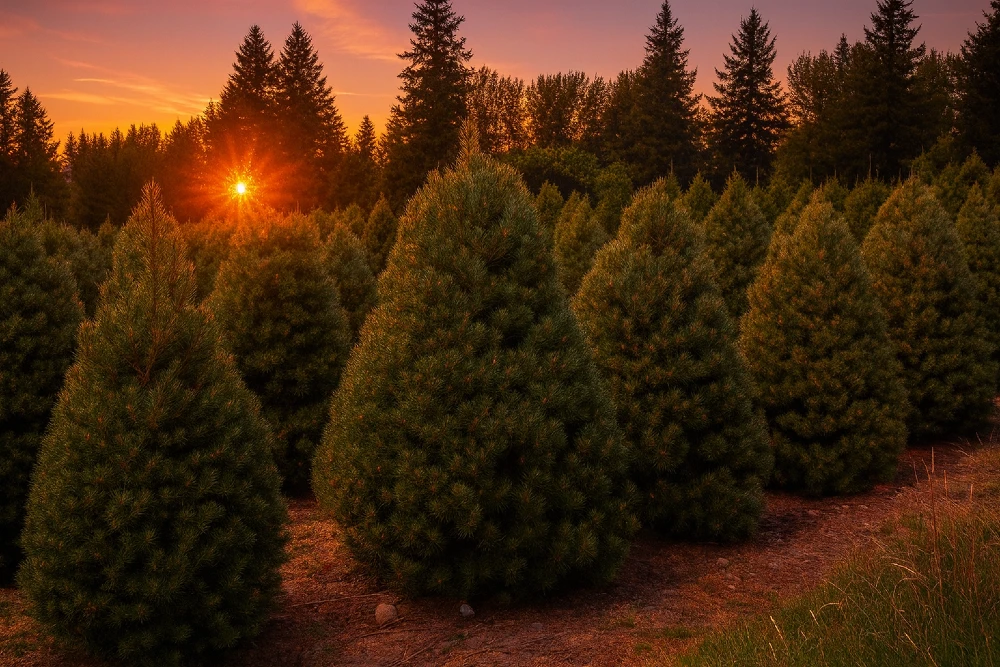Scotch Pine Christmas Tree Guide

Is the Scotch Pine a Good Christmas Tree?
If you’re trying to choose the best tree for Christmas, the Scotch Pine Christmas Tree (also called Scots Pine) has been one of North America’s most popular picks for decades. Families love it for its sturdy branches, vibrant green needles, and legendary ability to hold onto those needles all season long.
Ever since it became the most planted Christmas tree in the U.S. during the mid-20th century, Scotch Pine has been a go-to for both U-cut farm adventures and convenient pre-cut lots. It’s hardy, adaptable, and has that timeless “classic pine look” many people picture when they think of Christmas morning.
Pros:
- Excellent needle retention (minimal mess indoors)
- Strong branches that support heavy ornaments
- Classic bright-green color and conical shape
- Durable during transport and display
Cons:
- Less fragrant than firs (subtle scent)
- Requires regular shearing by growers for best form
- Vulnerable to certain pests and fungal diseases
Description & Common Characteristics of the Scotch Pine
The Scotch Pine (Pinus sylvestris) is the most widely distributed pine in the world, native to Europe and Asia but long naturalized in North America. As a Christmas tree, it grows into a dense, pyramidal shape when properly sheared — the kind that looks perfect in family photos by the fireplace.
Its needles grow in pairs, about 1 to 3 inches long, with a bright to dark green color that holds well indoors. The bark is grayish on the lower trunk but often flakes into orange-brown patches higher up, adding a bit of rustic character.
Historically, Scotch Pine became the dominant Christmas tree in the U.S. after World War II. Farmers loved how adaptable it was to different soils and climates, and families appreciated its toughness: unlike many other trees, even when dry, its needles cling stubbornly to the branches instead of showering the floor.
Needle Retention & Fragrance
How long will it last? Scotch Pine is famous for its ability to hold needles, even when it dries — in fact, it often outperforms Douglas Fir in this respect. The fragrance, however, is much milder than the resinous ‘Christmas smell’ of a Fraser or the subtle citrus notes of the Nordmann Fir.
As for fragrance, the Scotch Pine has a mild, fresh scent. It’s not as pungent as Fraser or Balsam Firs, but many families enjoy its subtle pine aroma that doesn’t overwhelm small spaces.
Where Do Scotch Pine Christmas Trees Grow?
In the wild, Scotch Pine ranges across Scotland, Scandinavia, Russia, and parts of Asia, where it thrives in sandy or rocky soils. In North America, it was widely planted starting in colonial times and has since become a mainstay of Christmas tree farms.
Today, Scotch Pine is grown across the northern United States and much of Canada — especially in Michigan, Minnesota, Ontario, and Québec. Its hardiness and tolerance for poor soils made it the first large-scale Christmas tree crop in North America, and while other firs have overtaken it in popularity in recent decades, it remains a reliable farm favorite.
How Much Does a Scotch Pine Christmas Tree Cost?
Prices vary depending on size, location, and whether you’re buying from a pre-cut lot or a cut-your-own farm. On average, expect:
- Small (4–5 ft): $35–$55
- Medium (6–7 ft): $60–$95 (most common size)
- Large (8–10 ft): $100–$160+
Urban tree lots may charge more due to shipping and demand, while visiting a local farm often gives you fresher trees at more competitive prices — plus the fun of picking your own.
How to Care for a Scotch Pine Christmas Tree
Want your Scotch Pine to stay vibrant through the holidays? Follow this care checklist:
- Make a fresh cut — Saw off ½ inch from the trunk base before placing it in water.
- Keep water topped up — A Scotch Pine can drink a quart or more daily at first; never let the stand go dry.
- Choose the right spot — Place away from heat vents, fireplaces, and direct sunlight.
- Check daily — Monitor water and needle condition. Even with its legendary retention, hydration keeps it looking best.
- Vacuum lightly if needed — While needles cling well, an occasional sweep keeps the floor tidy.
With proper care, a Scotch Pine can last 3–5 weeks indoors, easily carrying you through Christmas and New Year’s.
Where to Find a Scotch Pine Christmas Tree Near You
Ready to bring one home? Scotch Pines are available at farms and lots across the U.S. and Canada. Whether you want the full cut-your-own experience or prefer a pre-cut tree, you’ll find plenty of Scotch Pine options nearby.
Use our Christmas tree farms directory to explore local growers, compare varieties, and plan your family’s holiday tradition.